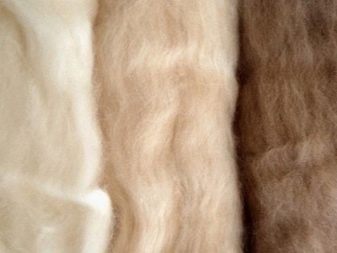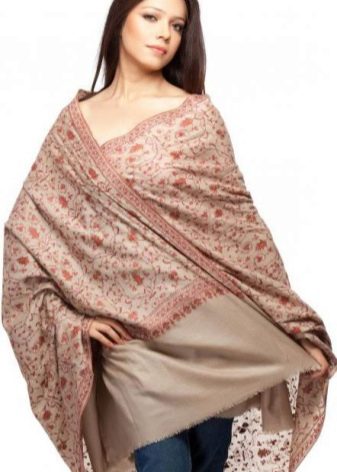All about pashmina

Pashmina is an expensive and refined wool, things from which it is not so easy to acquire. In the wardrobe of a fashionista, this will be a welcome acquisition, which is especially treated with care. Pashmina items require delicate care, they are often compared to cashmere items, and this is quite logical.

What is this material?
About three thousand years ago, pashmina was used to sew clothes for Indian shepherds. However, the fabric was not considered poor for long, its merits were very soon appreciated by the upper classes, after which elegant shawls and scarves were sewn from pashmina. The fabric is based on mountain goat down, which turned out to be not only practical, but also very delicate. And in Europe, pashmina was recognized only thanks to Napoleon, who brought a shawl from India for his beloved.
To be more precise, the birthplace of pashmina is the Himalayas. This word is translated as "down fabric", which is its exact characteristic. It is, in fact, made from the undercoat of goats that graze in the mountains. The fibers of goat fluff are 6 times thinner than a human hair, they have an even thickness along the entire length. The hairs themselves are almost entirely composed of the cortical layer, that is, they do not have an air core. There are 9-10 turns per 1 cm of hair.


Indian artisans weave pashmina in plain weave - the material is very thin and warm, with a slightly fleecy surface. Often the fabric is decorated with embroidery, but even a plain one, it looks very nice.


It is known that they tried to breed goats that produce such fluff in other regions - in Scotland, Australia, and the USA. But they did not achieve one hundred percent success: an animal that grows in a milder climate does not acquire such fluff as in the Himalayas.Its fibers are thicker, the curvature is worse, and the same air chamber is formed inside the hair.
And the manufacture of pashmina is associated with exclusively manual labor, multi-stage and complex. First, the yarn is prepared and twisted, then the threads are spun, then dyed, and, as a result, they are woven on special looms with a foot drive. By the way, pashmina is painted only with natural dyes, vegetable or mineral. Wool dyes well, you don't even need to boil it for a long time. And, most importantly, the colors will be resistant, the fabric almost does not fade.



Comparison with cashmere
Indeed, there is plenty of kinship in these fabrics - both species are made from the down of mountain goats native to India.... Yet these are not synonymous concepts. And the main difference lies in the thickness of the down. The yarn is obtained from the down of goats that live in the mountains of the Kashmir region, only the thickness of the down will depend on the climate where the goats graze. The higher the place of their pasture, the colder, therefore, the fluff of such animals grows faster and thicker, but at the same time it is very thin.
Cashmere is made from the down of goats that live in milder climates in the foothills. Wool for pashmina is taken from animals that graze higher - their undercoat will be thicker, the hairs themselves will be thicker.
To compare: the diameter of cashmere fibers is at least 18 microns, and pashmina - 12 microns. But human hair reaches 75 microns. The difference is, of course, tangible.


Views
There are plenty to choose from here. If the pashmina is completely woolen, it will be the most delicate and delicate material, the finest. If silk is added to the pashmina, then it can be all 40%. And also pashmina is single-layer and two-layer. The difference is based on the number of threads in addition. If the fabric is woven from a single thread, it will be as soft and thin as possible, if it is woven in two folds - denser and warmer. The second option is suitable for items that will be worn in cool, damp weather.


The most expensive and valuable type of pashmina is the one with the "ring" prefix.
This is the finest textiles that really will pass through a woman's ring. And also products made of such wool can be either patterned or dyed. The ornament can be obtained on the machine by intertwining multi-colored threads or by embroidering the finished canvas on both sides. Monochromatic things are woven with pre-dyed yarn, but they can be pigmented even at the finish of work.


Selection Tips
Of course, original products will be very expensive, not everyone will afford such wool, to put it mildly. And often, under the guise of pashmina, they sell a fake, not everyone can determine the discrepancy with the declared name.
How to choose real pashmina:
-
the surest option is to be in India, in the state of Kashmir, and ask local merchants for wool of mountain goats;
-
cheapness of the product - a clear sign of a fake, a real woolen shawl, for example, cannot cost less than $ 40, and if it is a complex product, and even with manual embroidery, the price can go for thousands and tens of thousands of conventional units;
-
edges are not even on hand-woven products (and pashmina is only handmade, exclusively), and the presence of irregularities, knots, small puffs is absolutely normal for this fabric;
-
if the edges of the product are even, which means that it was made on a machine, using coarser yarn - the work is no longer manual;
-
if you touch the cloth to your neck or wrist, and one feels a sting, even the slightest - this is not pashmina, it is so tender that it cannot prick;
-
Indian woolen products have no fringe, Turkish and Chinese have (pashmina is indeed brought from Turkey and China, but this is no longer the original).


In a word, the main selection criterion will be the price. A cheap product is not 100 percent pashmina.
Application
Shawls, shawls, stoles and all kinds of capes are the main segment where such valuable wool is used. Sweaters, hats and mittens won't be made of it.But those shawl-shaped products that are made of the most delicate fluff, and shades are usually natural, soft, cream.
This fabric is considered to be great in drapery. Therefore, you can put on a woolen stole on some basic, rather simple clothes, and it will lie exactly as you need it. The shoulders wrapped in it make the image romantic. And with a jumper, a pashmina scarf looks like an elegant, self-contained addition that fits beautifully and lends a feminine touch to the overall look.
Headscarves made of mountain goat down are also worn on the head, and they will not harm the hair (dry it out, electrify it).


Care rules
Of course, products made from this material are so expensive that caring for them is always anxious. And this is correct, if you tinker with it a little, a thing from pashmina can still be inherited by inheritance.
Care Tips:
-
an expensive thing, very thin, with embroidery or a beautiful pattern, it is better to give it to dry cleaning;
-
if it is decided to wash at home, the temperature of the water for washing should not rise above 25 degrees;
-
if the water is hot or cold, this will negatively affect the change in the structure of the down, and also reduce its warming properties;
-
if detergents are used, then only with a mild formula - only those marked "for wool", and with lanolin in the composition;
-
things can be soaked in soapy water, and then washed by hand, very gently, with unhurried movements, without much friction, stretching and compression;
-
after washing, the product must be squeezed very carefully, let the water drain from it, and then blot the thing with a towel (be sure to wrap it with a roller);
-
spread the product on a suitable horizontal surface, which is covered with a sheet made of natural fabric - you can dry pashmina on it;
-
dry and hot air, direct sunlight, this wool does not tolerate.


Very delicate and very expensive - this is how you can characterize the fabric that is brought from distant India. She is very pleasant to the skin. There are not many such things in the wardrobe, and the one that is available is cherished and worn for a very long time. Cashmere will cost less and is, one might say, a compromise option. But if they have already presented a pashmina scarf, this is a great reason for joy - almost like a diamond, only from the world of fabrics.










